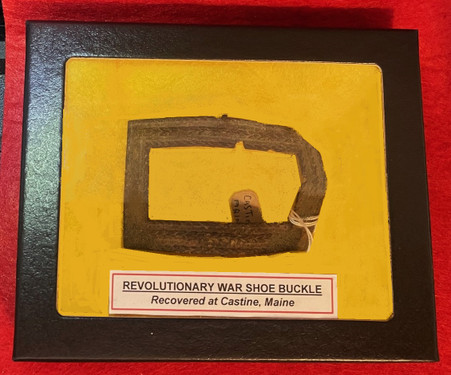 Loading... Please wait...
Loading... Please wait...-
Call us on (973) 810-2976
- My Account
- Gift Certificates
- Items / $0.00
All prices are in All prices are in USD
Categories
- Home
- Identified Artifacts
- Revolutionary War soldier’s shoe buckle, recovered at Castine, Maine
- Home
- Excavated Artifacts
- Revolutionary War soldier’s shoe buckle, recovered at Castine, Maine
- Home
- Personal Items
- Revolutionary War soldier’s shoe buckle, recovered at Castine, Maine
- Home
- Revolutionary War items
- Revolutionary War soldier’s shoe buckle, recovered at Castine, Maine
Revolutionary War soldier’s shoe buckle, recovered at Castine, Maine
Product Description
This is another nice piece being offered, it is an excavated Revolutionary War soldier’s shoe buckle – could be American or British. It is made of brass and measures 3” x 2”. This one was recovered at Castine, Maine and lost during the Penobscot Expedition.
The Penobscot Expedition was a 44-ship American naval armada assembled by the Provincial Congress of the Province of Massachusetts Bay. The flotilla of 19 warships and 25 support vessels sailed from Boston on July 19, 1779, for the upper Penobscot Bay in the District of Maine. The expeditionary force had more than 1,000 American colonial marines (not to be confused with the Continental Marines) and militiamen. Also included was a 100-man artillery detachment under the command of Lt. Colonel Paul Revere.
The expedition's goal was to reclaim control of mid-coast Maine from the British who had captured it a month earlier and renamed it New Ireland. It was the largest American naval expedition of the war. The fighting took place on land and at sea around the mouth of the Penobscot and Bagaduce rivers at Castine, Maine, over a period of three weeks in July and August. It resulted in the United States' worst naval defeat until Pearl Harbor 162 years later in 1941.
These shoe buckles were worn by soldiers from the mid-17th century through the 18th century. In “Collector’s Illustrated Encyclopedia of the American Revolution” by Neumann and Kravic, there are examples of these buckles (see pictures).
This shoe buckle is in nice condition and has kept its arched shape - there is a slight bend on one corner. There is also an example in the Colonial Williamsburg Museum (see pictures). It comes in the glass top display case pictured.




